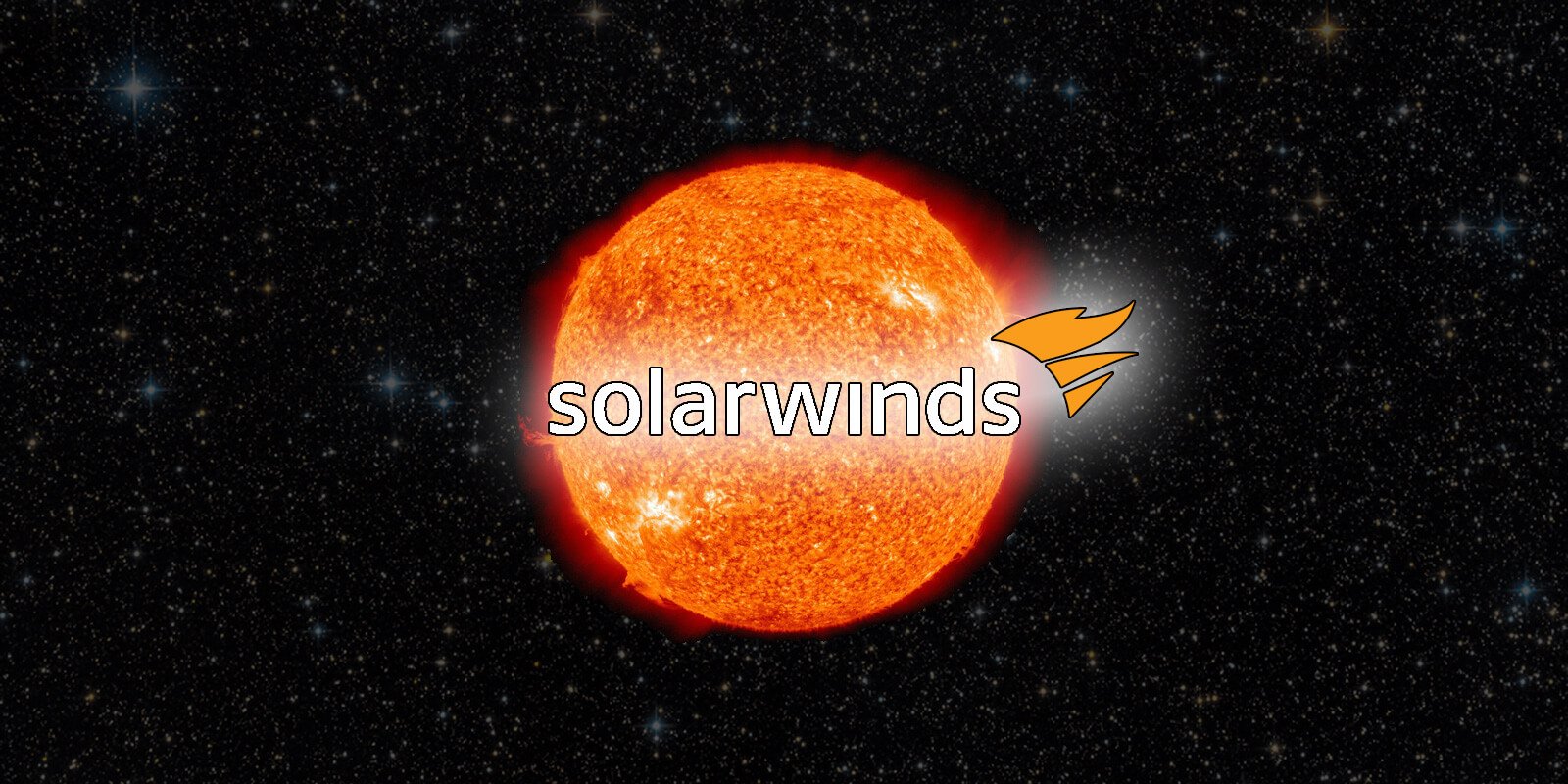
Since the SolarWinds supply chain attack was disclosed in December, there has been a whirlwind of news, technical details, and analysis released about the hack.
Because the amount of information that was released in such a short time is definitely overwhelming, we have published this as a roundup of SolarWinds news.
The information is distilled into a format that will hopefully explain the attack, who its victims are, and what we know to this point.
The SolarWinds supply chain attack
While we learned of SolarWinds' attack on December 13th, the first disclosure of its consequence was made on December 8th when leading cybersecurity firm FireEye revealed that it was hacked by a nation-state APT group. As part of this attack, the threat actors stole Red Team assessment tools that FireEye uses to probe its customers' security.
It was not known how the hackers gained access to FireEye's network until Sunday, December 13th, 2020, when Microsoft, FireEye, SolarWinds, and the U.S. government issued a coordinated report that SolarWinds had been hacked by state-sponsored threat actors believed to be part of the Russian S.V.R.
One of SolarWinds' customers who was breached in this attack is FireEye.
As part of the attack, the threat actors gained access to the SolarWinds Orion build system and added a backdoor to the legitimate SolarWinds.Orion.Core.BusinessLayer.dll DLL file. This DLL was then distributed to SolarWinds customers in a supply chain attack via an automatic update platform used to push out new software updates.
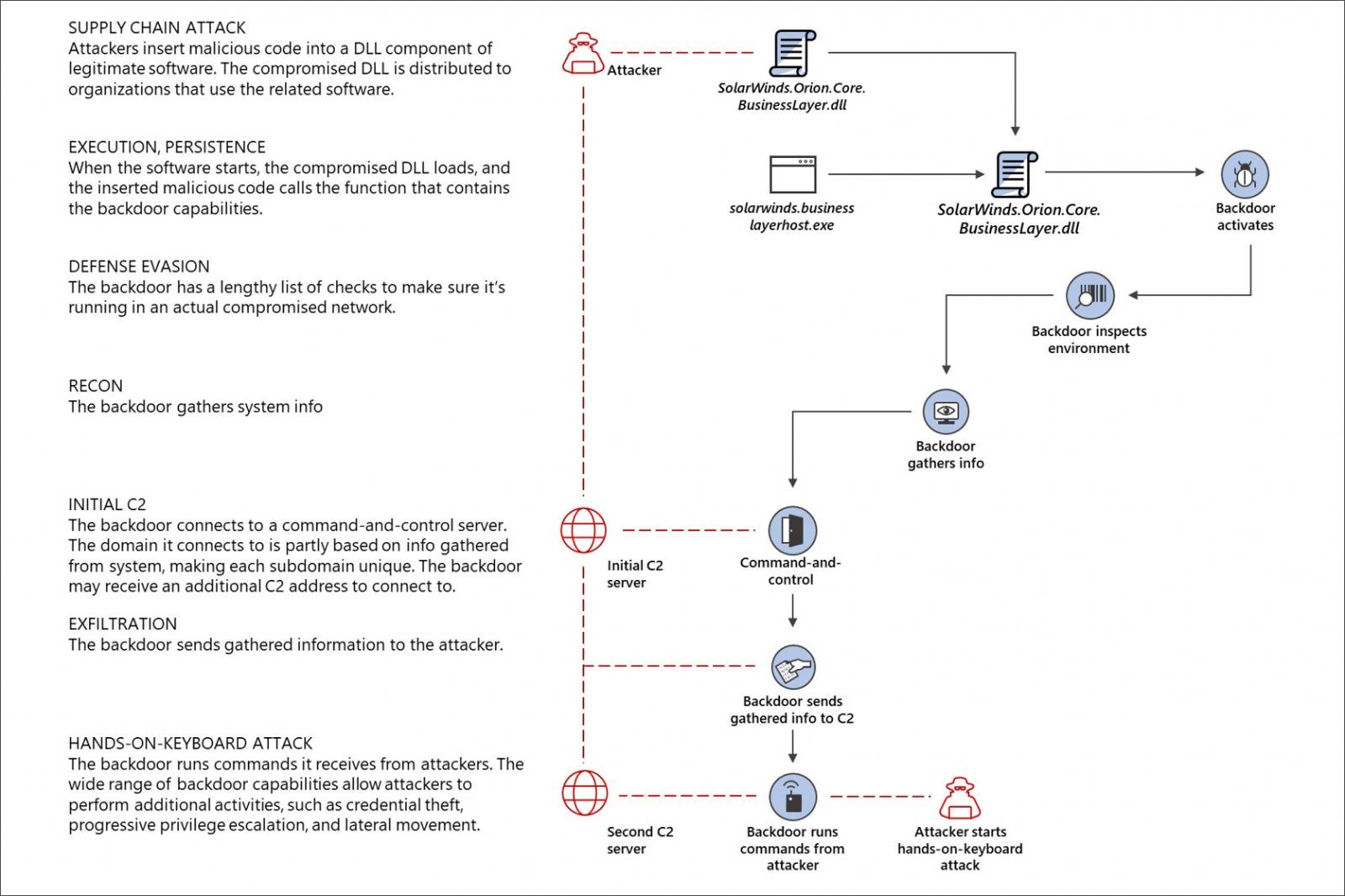
Source: Microsoft
This DLL backdoor is known as Sunburst (FireEye) or Solorigate (Microsoft, and is loaded by the SolarWinds.BusinessLayerHost.exe program. Once loaded, it will connect back to the remote command & control server at a subdomain of avsvmcloud[.]com to receive "jobs," or tasks, to execute on the infected computer.
The backdoor's command control server's DNS name is created utilizing a domain generation algorithm (DGA) to create an encoded subdomain of avsvmcloud[.]com. FireEye states that the subdomain is created by "concatenating a victim userId with a reversible encoding of the victims local machine domain name," and then hashed. For example, a subdomain used in this attack is '1btcr12b62me0buden60ceudo1uv2f0i.appsync-api.us-east-2[.]avsvmcloud.com.'
It is unknown what tasks were executed, but it could be anything from giving remote access to the threat actors, downloading and installing further malware, or stealing data.
Microsoft published a technical writeup on Friday for those interested in the technical aspects of the Sunburst backdoor.
A report by Kim Zetter released Friday night indicates that the threat actors may have performed a dry run of the distribution method as early as October 2019. During this dry run, the DLL was distributed without the malicious Sunburst backdoor.
After the threat actors began distributing the backdoor in March 2020, researchers believe that the attackers have been silently sitting in some of the compromised networks for months while harvesting information or performing other malicious activity.
Zetter's report stated that FireEye eventually detected they were hacked after the threat actors registered a device to the company's multi-factor authentication (MFA) system using stolen credentials. After the system alerted the employee and the security team of this unknown device, FireEye realized that they had been compromised.
Additional malware discovered
After performing investigations of SolarWinds supply chain victims, researchers have begun to get a better idea of the different malware used in the attack.
According to CrowdStrike, a malware named SunSpot was first executed in the SolarWinds network to monitor for and automatically inject the Sunburst backdoor in the SolarWinds development builds.
The Sunburst backdoor would then be transferred to victims via automatic updates for the SolarWinds Orion platform. Once executed, it would routinely connect to a remote command and control server for commands to execute on the infected device.
FireEye discovered that the Sunburst backdoor would drop a malware named Teardrop, which is a previously unknown memory-only dropper and a post-exploitation tool used to deploy customized Cobalt Strike beacons.
Finally, Symantec discovered the RainDrop malware, which was also used to deploy Cobalt Strike beacons on other hosts in an already compromised network.
The hackers behind the SolarWinds attack
FireEye is currently tracking the threat actor behind this campaign as UNC2452, while Washington-based cybersecurity firm Volexity has linked this activity to a hacking group known under the Dark Halo moniker.
Volexity says that Dark Halo actors have coordinated malicious campaigns between late 2019 and July 2020, targeting and successfully compromising the same US-based think tank three times in a row.
“In the initial incident, Volexity found multiple tools, backdoors, and malware implants that had allowed the attacker to remain undetected for several years,” the company said.
In the second attack, after being cast out from the victim’s network, Dark Halo leveraged a newly disclosed Microsoft Exchange server bug that helped them to circumvent Duo multi-factor authentication (MFA) defenses for unauthorized email access via the Outlook Web App (OWA) service.
During the third attack targeting the same think tank, the threat actor used the SolarWinds supply chain attack to deploy the same backdoor Dark Halo used to breach FireEye's networks and several U.S. government agencies.
Unconfirmed media reports have also cited sources linking the attacks to APT29 (aka Cozy Bear), a state-sponsored hacking group associated with the Russian Foreign Intelligence Service (SVR).
Researchers, including FireEye, Microsoft, or Volexity, have not attributed these attacks to APT29 at this time.
Reminder: Neither FireEye (UNC 2452), Microsoft (untamed, but no public references tying to YTTRIUM), nor Volexity (Dark Halo) have linked SolarWinds event to APT29...
— Joe Slowik (@jfslowik) December 17, 2020
The Russian Embassy in the USA reacted [1, 2] to these media reports saying that they were an “unfounded attempt of the U.S. media to blame Russia for hacker attacks on U.S. governmental bodies.”
“Russia does not conduct offensive operations in the cyber domain,” the Embassy added.
While Russia continues to deny these attacks, Secretary of State Mike Pompeo stated in an interview released Friday night that it is “pretty clear” that Russia was behind that attack.
“This was a very significant effort, and I think it’s the case that now we can say pretty clearly that it was the Russians that engaged in this activity,” Pompeo told radio host Mark Levin.
Microsoft believes that the ultimate goal of these attacks was to gain access to victims' cloud assets after deploying the Sunburst/Solorigate backdoor on their local networks.
The victims of the attack
Researchers believe that the malicious DLL was pushed out to approximately 18,000 customers as part of this attack.
The threat actors, though, only targeted organizations that they perceived as 'high value,' so even though some of these customers may have received the DLL, it is unknown if they were actively targeted in further attacks.
The currently known list of organizations that were hit by the SolarWinds supply chain attack include:
- FireEye
- U.S. Department of the Treasury
- U.S. National Telecommunications and Information Administration (NTIA)
- U.S. Department of State
- The National Institutes of Health (NIH) (Part of the U.S. Department of Health)
- U.S. Department of Homeland Security (DHS)
- U.S. Department of Energy (DOE)
- U.S. National Nuclear Security Administration (NNSA)
- Some US states (Specific states are undisclosed)
- Microsoft
- Cisco
Microsoft has also identified and notified more than 40 of its customers affected by this attack but has not disclosed their names. They state that 80% of the victims were from the U.S., and 44% were in the IT sector.
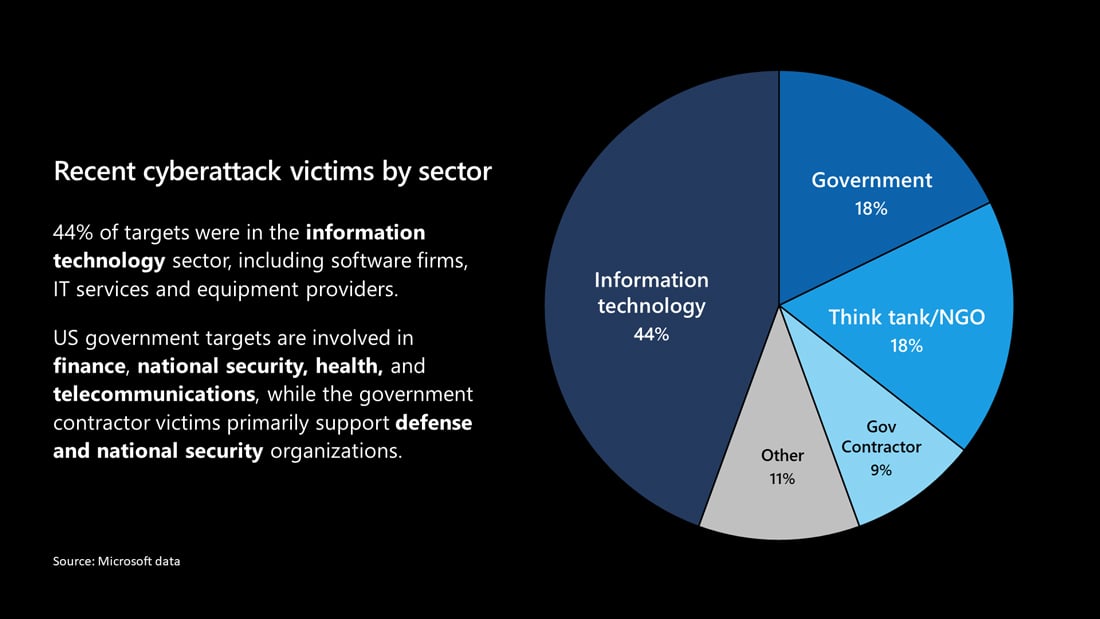
Based on the decoding of subdomains generated by the malware domain generation algorithm (DGA), many well-known companies may disclose targeted attacks at a later date.
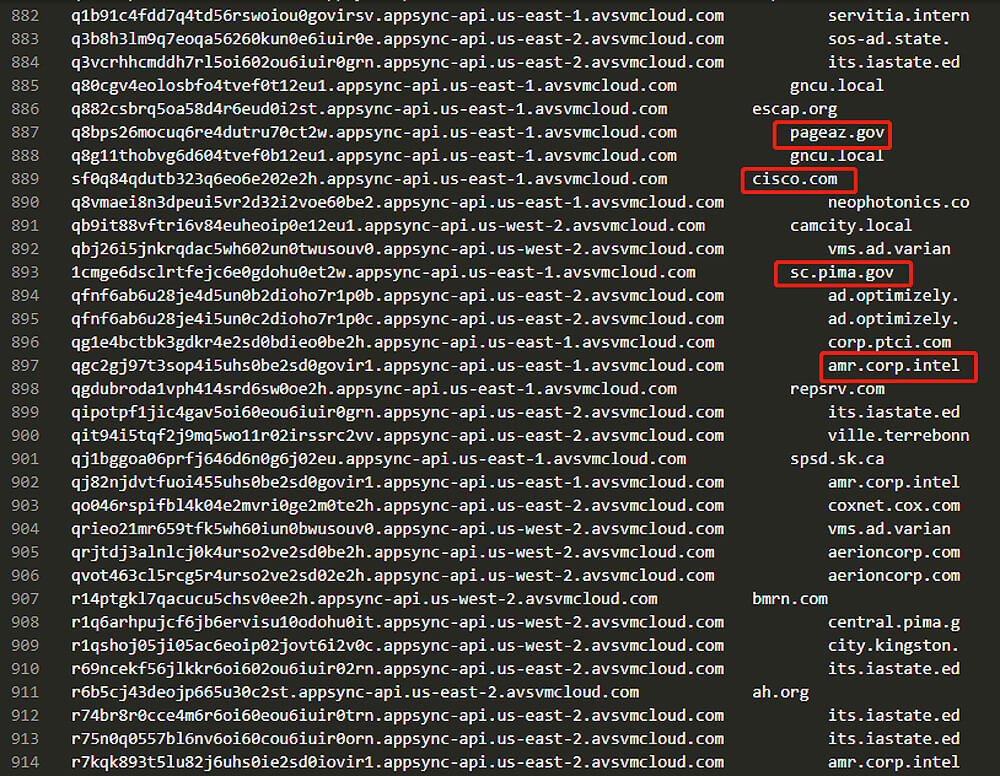
Source: RedDrip Team
What are security firms doing to protect victims
Since the cyberattack has been disclosed, security firms have been adding the malicious Sunburst backdoor binaries to their detections.
While Microsoft was already detecting and alerting customers of malicious SolarWinds binaries, they were not quarantining them out of concern it could affect an organization's network management services. On December 16th, at 8:00 AM PST, Microsoft Defender began quarantining detected binaries even if the process is running.
Microsoft, FireEye, and GoDaddy also collaborated to create a kill switch for the Sunburst backdoor distributed in the SolarWinds hack.
When the malicious binaries attempt to contact the command & control servers, they will perform DNS resolution to get the IP address. If this IP address is part of certain IP ranges, including ones owned by Microsoft, the backdoor will terminate and prevent itself from executing again.
To create the kill switch, GoDaddy created a wildcard DNS resolution so that any subdomain of avsvmcloud[.]com resolves to the IP address 20.140.0.1, which belongs to Microsoft and is on the malware's blocklist. This wildcard resolution is illustrated by a DNS lookup for a made-up subdomain, as shown below.
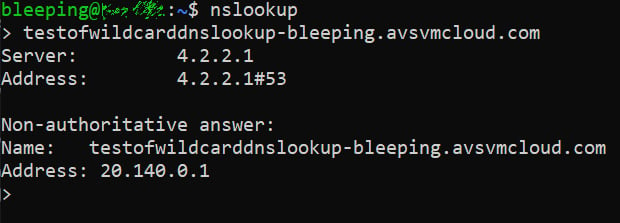
As this IP address is part of the malware's blocklist, when it connects to any subdomain of avsvmcloud[.]com, it will unload and no longer execute.
While this kill switch will disable Sunburst backdoor deployments connecting the command & control servers, FireEye has stated the threat actors may have deployed other backdoors.
"However, in the intrusions FireEye has seen, this actor moved quickly to establish additional persistent mechanisms to access to victim networks beyond the Sunburst backdoor. This killswitch will not remove the actor from victim networks where they have established other backdoors. However, it will make it more difficult to for the actor to leverage the previously distributed versions of Sunburst," FireEye warned about the kill switch," FireEye told BleepingComputer in a statement.
How to check if you were compromised
If you are a user of SolarWinds products, you should immediately consult their advisory and Frequently Asked Questions as it contains necessary information about upgrading to the latest 'clean' version of their software.
Microsoft has also published a list of nineteen malicious SolarWinds.Orion.Core.BusinessLayer.dll DLL files spotted in the wild.
This list, shown below, contains a file's SHA256 hash, the file version, and when it was first seen.
| SHA256 | File Version | Date first seen |
| e0b9eda35f01c1540134aba9195e7e6393286dde3e001fce36fb661cc346b91d | 2020.2.100.11713 | February 2020 |
| a58d02465e26bdd3a839fd90e4b317eece431d28cab203bbdde569e11247d9e2 | 2020.2.100.11784 | March 2020 |
| 32519b85c0b422e4656de6e6c41878e95fd95026267daab4215ee59c107d6c77 | 2019.4.5200.9083 | March 2020 |
| dab758bf98d9b36fa057a66cd0284737abf89857b73ca89280267ee7caf62f3b | 2020.2.100.12219 | March 2020 |
| eb6fab5a2964c5817fb239a7a5079cabca0a00464fb3e07155f28b0a57a2c0ed | 2020.2.100.11831 | March 2020 |
| c09040d35630d75dfef0f804f320f8b3d16a481071076918e9b236a321c1ea77 | Not available | March 2020 |
| ffdbdd460420972fd2926a7f460c198523480bc6279dd6cca177230db18748e8 | 2019.4.5200.9065 | March 2020 |
| b8a05cc492f70ffa4adcd446b693d5aa2b71dc4fa2bf5022bf60d7b13884f666 | 2019.4.5200.9068 | March 2020 |
| 20e35055113dac104d2bb02d4e7e33413fae0e5a426e0eea0dfd2c1dce692fd9 | 2019.4.5200.9078 | March 2020 |
| 0f5d7e6dfdd62c83eb096ba193b5ae394001bac036745495674156ead6557589 | 2019.4.5200.9078 | March 2020 |
| cc082d21b9e880ceb6c96db1c48a0375aaf06a5f444cb0144b70e01dc69048e6 | 2019.4.5200.9083 | March 2020 |
| ac1b2b89e60707a20e9eb1ca480bc3410ead40643b386d624c5d21b47c02917c | 2020.4.100.478 | April 2020 |
| 019085a76ba7126fff22770d71bd901c325fc68ac55aa743327984e89f4b0134 | 2020.2.5200.12394 | April 2020 |
| ce77d116a074dab7a22a0fd4f2c1ab475f16eec42e1ded3c0b0aa8211fe858d6 | 2020.2.5300.12432 | May 2020 |
| 2b3445e42d64c85a5475bdbc88a50ba8c013febb53ea97119a11604b7595e53d | 2019.4.5200.9078 | May 2020 |
| 92bd1c3d2a11fc4aba2735d9547bd0261560fb20f36a0e7ca2f2d451f1b62690 | 2020.4.100.751 | May 2020 |
| a3efbc07068606ba1c19a7ef21f4de15d15b41ef680832d7bcba485143668f2d | Not available | Not available |
| a25cadd48d70f6ea0c4a241d99c5241269e6faccb4054e62d16784640f8e53bc | 2019.4.5200.8890 | October 2019 |
| d3c6785e18fba3749fb785bc313cf8346182f532c59172b69adfb31b96a5d0af | 2019.4.5200.8890 | October 2019 |
Finally, security researchers have released various tools that allow you to check if you were compromised or what credentials were stored in your SolarWinds Orion installation.
- SolarFlare Release: Password Dumper for SolarWinds Orion
-
SpearTip’s SolarWinds’ Orion Vulnerability Tool SunScreen – SPF 10
The source code for both projects is published to GitHub. You are strongly encouraged to review the source code, if available, of any program you plan to run on your network.
Security researcher Cory Kennedy has also released a python tool to help you find the Sunburst malware on your network.
This tool is called Sunburst hunter and can be downloaded from the project's GitHub page.
SolarWinds Orion abused in other supply chain attacks
During the investigation into the SolarWinds hack, Palo Alto Networks and Microsoft found an additional malware named SUPERNOVA distributed using the App_Web_logoimagehandler.ashx.b6031896.dll DLL file.
This malware is a backdoor that allowed the threat actors to send C# code that would be compiled and executed by the malware.

This malware is not believed to be related to the SolarWinds.Orion.Core.BusinessLayer.dll supply chain attack. It does, though, indicate that the SolarWinds Orion platform was used in two different attacks, and possibly by different groups, to distribute malware.
Last week, SolarWinds released an update advisory that advises all Orion Platform customers to upgrade to the latest versions to be protected from not only the SUNBURST vulnerability but the SUPERNOVA malware as well.
Additional reporting by Sergiu Gatlan and Ionut Ilascu.
Update 12/19/20: Added Cisco to the victim list.
Update 12/27/20: Added information about second SUPERNOVA malware.
Update 01/20/20: Added information about further malware


Comments
Mike_Walsh - 3 years ago
Interesting, yet hardly surprising to note that the entire thing has been exclusively targeted solely against the US... (*shrug*)
Some-Other-Guy - 3 years ago
"While Russia continues to deny these attacks, Secretary of State Mike Pompeo stated in an interview released Friday night that it is “pretty clear” that Russia was behind that attack."
-------------
That's great
Maybe Pomeo should inform the President that all the fake intel indicating that the Presedential election was stolen actually came from hacks like this, and that Trump actually is the BIGGEST LOSER in political history
After all, he needs accurate Intel, doesn't he?
LoL
If you have evidence that it was the Russians, then show me the evidence
It's kinda hard to believe anything Pomeo say's at this point
Joepete - 3 years ago
Attributing a cyber attack can be a very complex process. The opportunity for "false flag" attribution is immense. Consider this: If Country B appears to be able to break into the infrastructure of Country C, who is to say that Country A did not break into B and launch the attacks from its infrastructure?
EmanuelJacobsson - 3 years ago
Dont feed the troll.
Some-Other-Guy - 3 years ago
This just in.....
Even Trump disputes Pompeo's allegation!
https://www.cnbc.com/2020/12/19/trump-contradicts-pompeo-plays-down-alleged-russian-role-in-hack.html
igioz - 3 years ago
what about weak Solarwinds password?
Some-Other-Guy - 3 years ago
What about Commie Joe winning the election ?
https://www.newsweek.com/trump-tweets-solarwinds-hack-voter-fraud-election-loss-1556165
and why so few comments on the biggest hack ever ?
Whats wrong with this picture ?
buddy215 - 3 years ago
The believers in false conspiracy theories and the elective ignorant fail to recognize or admit that voting machines are NOT connected to the Internet. Without the false conspiracy theorists believers and the elective ignorant voters....the Republican Party would shrink to totally irrelevant. .
Some-Other-Guy - 3 years ago
Democrats (the promoters of false conspiracy theories) are blaming Russia without evidence and demanding Trump do something immediately to punish them for the attack
Just read the news, starting with CNN to see what I mean
A reasonable person would gather "EVIDENCE" to show who committed the attack before striking back and present the evidence for independent verification
If the Russians were already in more than 18,000 critical computers and networks for more than 6 months, then why did Biden win the election?
If we are going to speculate without evidence, then a biden win might rather point to China or even the Democrats themselves as the source of the attack
Let's wait and see what the "EVIDENCE" says as to who did what instead of resorting to wild conspiracy theories
Who exactly were the targets of the attack?
Was one political party attacked more than the other?
and what evidence do you have that it was the Russians?
Lawrence Abrams - 3 years ago
Comments will be closed if they continue to derail the topic of this article. If you want to discuss politics, there are plenty of threads in the speak easy forum.
Some-Other-Guy - 3 years ago
I'd like to hear your input on the source
Have you seen any actual "evidence" as to the source, and if so, can "we" see the evidence as well?
EmanuelJacobsson - 3 years ago
Please just go ahead and close the comment section, this isnt going anywhere anyways.
EmanuelJacobsson - 3 years ago
Dont feed the troll guys...